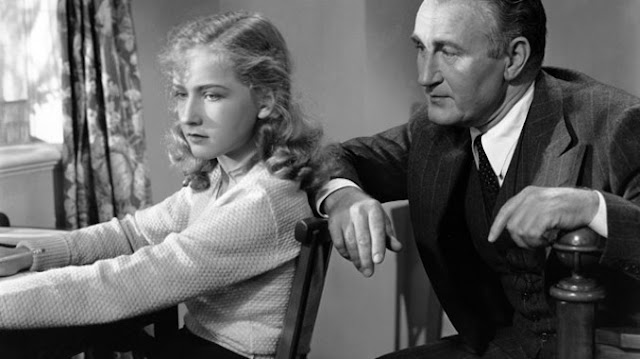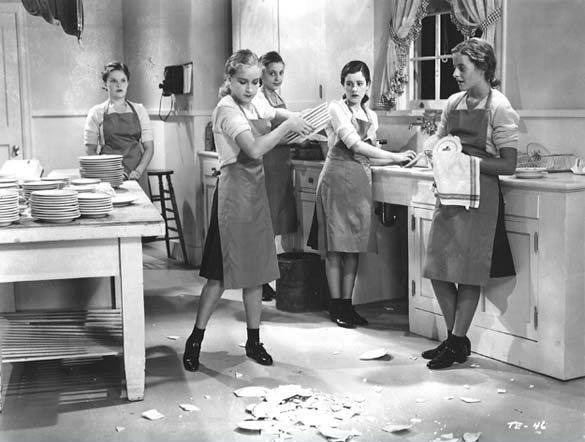The Beloved Brat is based on an original story by Jean Negulesco, who was on loan to Warner Bros. as a writer in 1938 and soon transitioned into a career as a director. Directed by Arthur Lubin, the film stars Bonita Granville as Roberta Morgan, the only child of a wealthy couple. She's been primarily raised by the household servants and her governess because her mother Mrs. Morgan (Natalie Moorhead) and her father Mr. Morgan (Donald Crisp) are far too busy with their careers and travels to pay much attention to their daughter. This results in Roberta acting out. A lot. The more Roberta feels stifled, the more she acts out and the more they try to repress her. It's a vicious cycle. The one person who seems to be emotionally invested in her is her father's secretary Williams (Donald Briggs). He's also the only person to remember her on her birthday which turns ends with a sad little party only attended by the servants and with cake she doesn't even get to eat.
 |
| Bonita Granville and Donald Crisp in The Beloved Brat (1938) |
When Roberta discovers a young boy playing her front lawn she befriends him. Pinkie (Matthew Stymie Beard) and his sister Arabella (Meredith White) include her in their adventures. It turns out Roberta could care less about the fact that they're black. (Side note: Leo Gorcey has a small role as a bully in one of their scenes.) When Roberta brings Pinkie home to have dinner, Roberta's story takes a turn for the worse. Jenkins (Emmet Vogan), the butler, unceremoniously throws Pinkie out of the house and locks Roberta in her room. She fakes a house fire in order to run away but this starts a series of events which lands her in a reform school for girls run by Helen Cosgrove (Dolores Costello) and Miss Brewster (Lucille Gleason). Roberta is in a completely new and foreign environment and the schoolgirls take a disliking to her almost immediately. With the help of Cosgrove and the indirect help of her friend Williams, Roberta blossoms into a well-behaved young woman. And now it's time for her parents to learn their lesson.
 |
| Roberta (Bonita Granville) smashing plates as her fellow school girls look on.The Beloved Brat (1938) |
The Beloved Brat is a film ahead of its time. In an era when racial mixing was looked down upon, the underlying message of inclusiveness in the film is quite bold. I let out a yelp and began to cry when I saw that Roberta finally got the birthday party she deserved, one filled with friends, including Pinkie and Meredith, and lots of cake. And in a time when it was the norm that children should be seen and not heard, Roberta boldly makes herself known. I wonder how audiences in 1938 reacted to this film. Were they receptive to the film's messages or did they just dismiss it as another poor rich girl story?
Bonita Granville is one of my favorite actresses but not all of her characters are likable. She made a career out of playing spoiled brats. Don't tell me you watched Now, Voyager (1942) and didn't feel the urge to smack her across the face. Granville's Roberta is lovable though. You know she's acting out because of her awful parents. I felt an emotional tie to her character and cheered her on and even wanted to see her throw a tantrum or two.
Granville made a minor splash in Hollywood playing a brat in These Three (1936). A few months after The Beloved Brat, Granville would start in the first of the four Nancy Drew movies, Nancy Drew Detective (1938). I have watched all four Nancy Drew films countless times and they're still some of my favorite movies from that era. I love that Granville graduates from brat, to misunderstood brat and then to headstrong independent girl in just a couple of years. But her bratty roles would still be synonymous with her name.
The Beloved Brat (1938) aired recently on TCM but it's not available on DVD. I hope the Warner Archive Collection will release it sometime in the future. It's worth seeing especially if you love films from this era and if you have a soft spot for Bonita Granville like I do.

















